Web Menu
Product Search
Exit Menu
Exploring the Unique Features and Applications of Best Wicker Furniture Styles
As we move towards 2025, the outdoor furniture market is projected to reach over $20 billion, driven by shifting consumer preferences for sustainable and stylish home decor.
 Wicker furniture, renowned for its durability and aesthetic appeal, is increasingly becoming a focal point in both residential and commercial spaces. Industry reports indicate that the demand for wicker styles, particularly eco-friendly options, has surged by 30% in the last few years, highlighting a significant shift towards sustainable living. Features such as weather resistance, lightweight design, and versatile styles further enhance its popularity, making wicker furniture an ideal choice for various applications—from patios to indoor settings.
In this blog, we will explore the unique features and applications of the best wicker furniture styles, along with a comprehensive checklist to help you choose the perfect pieces for your space.
Wicker furniture, renowned for its durability and aesthetic appeal, is increasingly becoming a focal point in both residential and commercial spaces. Industry reports indicate that the demand for wicker styles, particularly eco-friendly options, has surged by 30% in the last few years, highlighting a significant shift towards sustainable living. Features such as weather resistance, lightweight design, and versatile styles further enhance its popularity, making wicker furniture an ideal choice for various applications—from patios to indoor settings.
In this blog, we will explore the unique features and applications of the best wicker furniture styles, along with a comprehensive checklist to help you choose the perfect pieces for your space.
Unique Characteristics of Wicker Furniture: Materials and Craftsmanship
Wicker furniture, known for its intricate designs and natural appeal, has captivated homeowners with its unique characteristics rooted in materials and craftsmanship. Primarily constructed from rattan, bamboo, or reeds, wicker is celebrated for its sustainability and lightweight nature. The natural materials lend warmth to any space, making wicker furniture an ideal choice for both indoor and outdoor settings. The weaving techniques employed vary, with some craftsmen opting for traditional hand-woven designs, while others utilize modern methods that enhance durability and comfort.

The craftsmanship of wicker furniture plays an essential role in its uniqueness. Artisans often spend hours meticulously weaving intricate patterns that not only enhance the aesthetic appeal but also contribute to the furniture's strength. The versatility of wicker is another highlight; it can be adapted into various styles, from contemporary to rustic. Additionally, the surface can be finished with a variety of paints and stains, allowing for personalization that suits individual tastes. This blend of artistry and functionality ensures that wicker furniture remains a timeless choice for those looking to add a touch of elegance to their homes.
The Evolution of Wicker Furniture Styles Through the Decades
Wicker furniture has undergone a significant transformation over the decades, evolving from a simple utilitarian design to a stylish staple in both indoor and outdoor spaces. In the 1970s, the rise of bohemian culture saw a surge in interest for handwoven wicker pieces, reflecting a desire for artisanal craftsmanship. According to a report by the American Home Furnishings Alliance, the demand for wicker furniture continues to grow, with a projected market increase of 6% annually through 2025. This growth is driven by consumer preferences for sustainable materials and versatile designs that can effortlessly blend with various home aesthetics.
When selecting the right wicker furniture for your space, consider incorporating natural fibers like rattan or bamboo, which not only offer durability but also enhance the visual appeal of the piece. Tip: Always check for UV-resistant finishes, especially for outdoor furniture, to maintain its longevity against fading and wear. Another noteworthy trend is the infusion of modern colors and patterns, allowing wicker to complement contemporary interiors seamlessly. Tip: Choose cushions with removable, washable covers to ensure upkeep and maintain cleanliness while preserving the vibrancy of your wicker furniture.
The late 20th century heralded a shift towards more minimalistic designs, emphasizing clean lines and functional forms. Recent data from the International Casual Furnishings Association indicates that consumers are gravitating towards multifunctional wicker pieces, such as storage ottomans or convertible tables, which reflect the evolving lifestyle demands of today’s homeowners. In this way, wicker furniture not only preserves its charm but continues to adapt, offering timeless appeal in a modern context.
Top Applications of Wicker Furniture in Residential and Commercial Spaces
Wicker furniture has been a favored choice in both residential and commercial settings due to its versatility, durability, and aesthetic appeal. In residential spaces, homeowners increasingly seek sustainable furnishing options, with the global rattan furniture market projected to reach $15.4 billion by 2025, according to a recent industry report. This surge can be attributed to the growing preference for eco-friendly materials, as wicker pieces not only enhance the visual appeal of living rooms and patios but also resist everyday wear and tear. With various styles, including traditional and modern designs, wicker furniture offers homeowners the ability to adapt their interiors to current trends while ensuring longevity.
In commercial environments, wicker furniture has found significant applications in hotels, cafes, and outdoor dining venues. A study by the National Association of Restaurant Owners indicates that 35% of establishments have increasingly incorporated outdoor seating strategies to attract customers, with wicker being a popular choice due to its lightweight nature and classic look. Additionally, wicker’s ability to withstand diverse weather conditions makes it ideal for patios and poolside areas, accommodating businesses looking to maximize space and enhance customer experience. As property owners explore innovative design solutions, the demand for wicker furniture in both private and public spaces continues to grow, reflecting a broader trend toward stylish yet practical furnishings.
Exploring the Unique Features and Applications of Best Wicker Furniture Styles - Top Applications of Wicker Furniture in Residential and Commercial Spaces
| Wicker Furniture Style | Unique Features | Common Applications | Ideal Material |
|---|---|---|---|
| Natural Wicker | Made from natural materials, offering a rustic look | Living rooms, outdoor patios | Rattan, wicker grass |
| Synthetic Wicker | Durable and weather-resistant, low maintenance | Commercial patios, poolside lounges | HDPE (high-density polyethylene) |
| Peacock Chair | Iconic fan-shaped backrest, bohemian style | Photo shoots, decorative living spaces | Natural rattan or cane |
| Wicker Tables | Lightweight, easy to move, various shapes | Dining areas, coffee shops | Rattan, resin |
| Wicker Rocking Chair | Comfortable seating with a soothing rocking motion | Porches, nurseries | Natural wicker, synthetic options available |
Market Trends: Consumer Preferences and Sales Data in Wicker Furniture Industry
The wicker furniture market is set to thrive within the broader context of the global outdoor furniture industry, which is projected to grow from $56 billion in 2025 to $81.44 billion by 2032, representing a compound annual growth rate (CAGR) of 5.50%. As consumer preferences shift towards sustainable and aesthetically pleasing designs, wicker furniture, encompassing both traditional and modern styles, is gaining popularity. This trend underscores the importance of understanding consumer behavior and market data that indicate increasing demand for versatile and durable outdoor solutions.
When choosing wicker furniture, opt for styles that complement your outdoor space while also reflecting your personal taste. Consider the durability of materials used, as well-made wicker can withstand varying weather conditions. Additionally, accessorizing your wicker furniture with vibrant cushions and throws can enhance comfort and add a pop of color, making your outdoor area inviting.
It's essential to stay informed about market trends and consumer preferences. For instance, modular wicker furniture is becoming increasingly popular due to its flexibility and functionality. By observing these trends, consumers can make smarter choices that not only elevate their outdoor aesthetics but also align with market demands for lasting and sustainable furniture options.
Sustainability in Wicker Furniture Production: Environmental Impact and Innovations
Sustainability has become a critical focus in the production of wicker furniture, as consumers increasingly demand environmentally friendly options. The wicker furniture industry is making strides in reducing its environmental impact through innovative practices. By utilizing sustainable materials, manufacturers are not only preserving natural resources but also creating durable products that resonate with eco-conscious consumers. Innovations in production techniques, such as using recycled plastics or responsibly sourced natural fibers, can significantly lower carbon footprints while ensuring high-quality output.
When designing or purchasing wicker furniture, consider these tips for enhancing sustainability: prioritize products made from renewable resources and look for certifications that indicate responsible production practices. Additionally, support brands that are transparent about their supply chains and environmental policies; this fosters greater accountability and encourages more companies to adopt sustainable practices. By making informed choices, consumers can contribute to a more sustainable furniture industry, aligning their purchasing habits with their values.

-
- about us
- About Us
- Qualification
- Privacy
-
- Packaging products
- Hot Sale
- Outdoor Sofa Sets
- Outdoor Dining Sets
- Outdoor Loungers/Sunbeds
- Swing Chairs
- Single Chair

 English
English España
España عرب
عرب 简体中文
简体中文